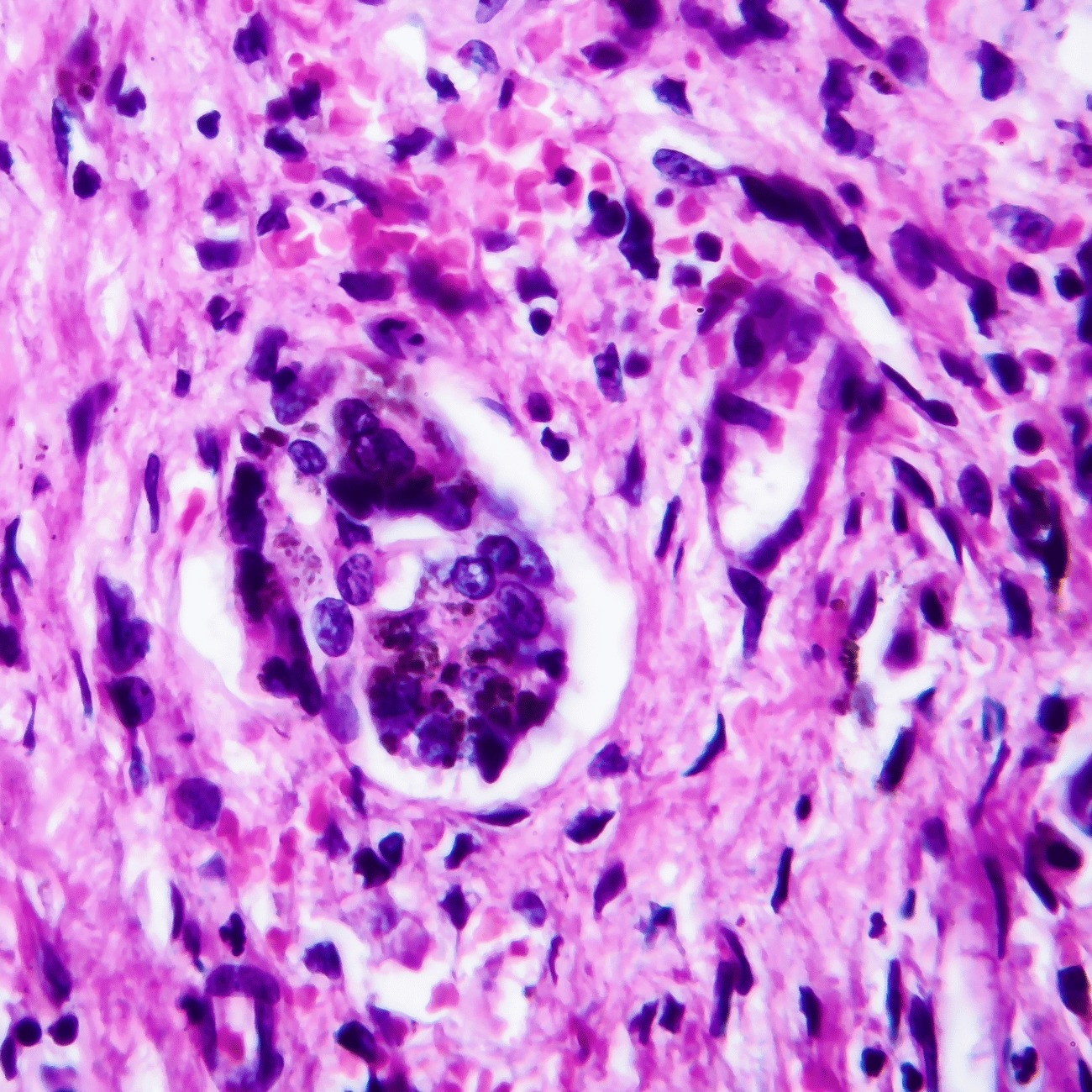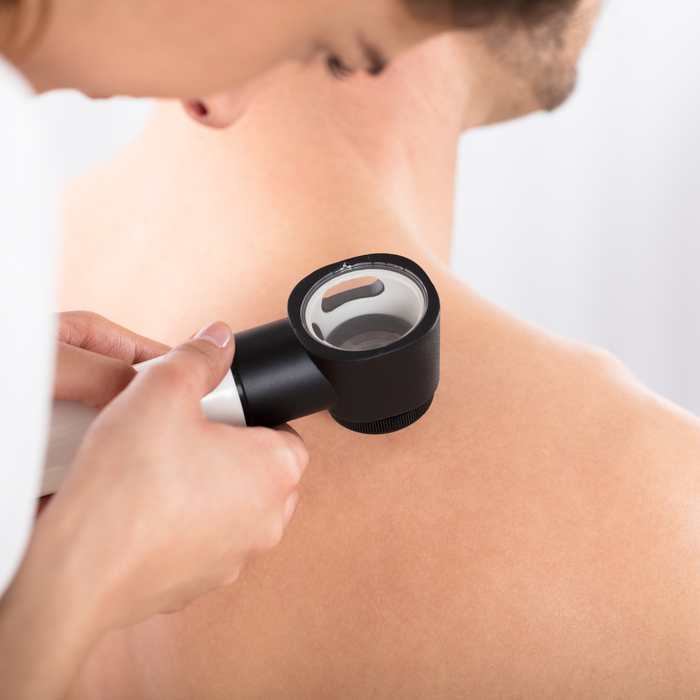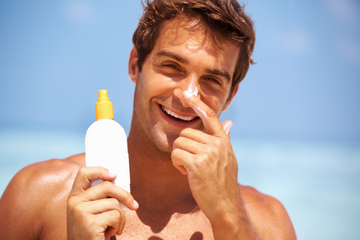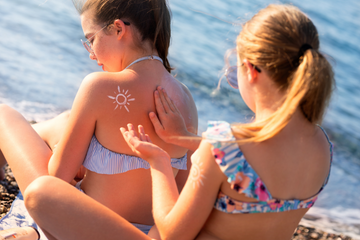Skin Cancer and Melanoma Awareness
Protect yourself and your family this summer!
Days to prepare for next Summer!
Days until Summer - be prepared.
-
Women
ButtonAustralia has the highest rate of skin cancer in the world, it’s even known as our national cancer.
-
Men
ButtonAustralian men urged to reduce their risk of skin cancer with new research showing they are less likely than women to use sun protection.
-
Children
ButtonUsing consistent sun protection during childhood can drastically reduce the risk of developing any type of skin cancer as an adult
-
Pets
ButtonMuch like humans pets can suffer from skin cancer and sun damage. Ensure that your best friend is protected by becoming more sun aware for your cat or dog.
5 Types of Skin Cancer!
Skin cancer represents a major public health issue, affecting millions of people worldwide.
It's a condition where malignant cells form in the tissues of the skin, and it's primarily categorised into three main types: basal cell carcinoma, squamous cell carcinoma, and melanoma.
While it's more prevalent in older adults due to cumulative sun exposure over time, younger adults, and in rare cases, children, are not immune to it. Understanding the risk factors and the biology behind skin cancer can help in its prevention, early detection, and treatment.
Age and Skin Cancer
Older adults are indeed at higher risk for developing skin cancer, as the risk increases with age. This is attributed to the accumulation of UV radiation exposure over the years. However, younger adults and even children can develop skin cancer, especially if they have significant sun exposure without adequate protection, use tanning beds, or have a predisposition due to genetic factors.
Skin Type and Risk
The Fitzpatrick skin phototype system classifies skin by its colour and its reaction to sun exposure, ranging from I (always burns, never tans) to VI (never burns, always tans). Types I, II, and III, which generally include fair-skinned individuals, are at a heightened risk for skin cancer due to lower levels of melanin. Melanin acts as a natural sunscreen by absorbing and dissipating UV rays. However, it's a common misconception that individuals with darker skin are immune to skin cancer. While the incidence rates are lower, when skin cancer does occur in darker skin types, it can be more deadly, often because of late detection.
Genetic Factors and Family History
The role of genetics in skin cancer cannot be overstated. Individuals who have a family history of skin cancer are at a higher risk, suggesting a genetic predisposition to developing the disease. Certain genes, like the melanocortin-1 receptor (MC1R), play a significant role in determining skin pigmentation and are linked to an increased risk of skin cancer. Mutations in this gene can lead to reduced melanin production and increased susceptibility to UV radiation damage.
Previous Skin Cancer
Having had one instance of skin cancer significantly raises the likelihood of developing another, partly because the same risk factors (like sun exposure and genetic predisposition) are often still present. This underscores the importance of regular skin checks and monitoring for individuals with a history of the disease.
Preventive Measures and Early Detection
Given these risk factors, preventive measures such as avoiding excessive sun exposure, using sunscreen, wearing protective clothing, and avoiding tanning beds are crucial. Early detection through regular skin examinations by a healthcare professional and self-examinations can significantly improve outcomes, as most skin cancers are treatable when caught early.
While certain factors like age, skin type, genetics, and family history increase the risk of skin cancer, it's crucial to remember that skin cancer can affect anyone. Awareness, preventive measures, and early detection are key components in reducing the impact of skin cancer across all demographics.


4 Easy Health and Fitness Tips to Reduce your Risk of Skin Cancer.
In short, we all need to be healthy and fit.
We each have our own reasons from looking good naked to being around for the kids, maybe the doctor ordered us too.
Obesity is the leading cause of death in Australia and most of the Western world.
All too often we fail to think about what we are doing to ourselves and our families. So do it for them as well as yourself.
If you need help, find a workout partner or get a fitness trainer. Look online, you will find they aren't all that expensive and can help motivate and guide you to you health and fitness goals.
Australia has seen an enormous increase in the number of people considered obese by the medical community. In fact many call it an obesity epidemic. To combat this, we find all sorts of pharamceutical companies selling the "quick fix" pills, powders, and lotions that do nothing to actually help people take the fat off and keep it off.
Of course the same could be said of the diet industry as well. There are so many different diets going around now you could pick one a month and in a years time still have more to choose from.
What is truely needed are some sensible proven weight loss tips that people can implement no matter what their current physical condition is. That said, let's dive right in.
Drink more water.
All too often Australians are borderline dehydrated and so their bodies are working on the water starvation reflex and not flushing the toxins and junk out.
Eat more often.
I bet you thought I was going to say eat less. While it is true that to lose weight you need to eat less calories than you expend...you need to eat more often to get the metabolic furnace fired up and burning right. Get it out of starvation mode. So start the day off with breakfast. Even an instant breakfast drink and a piece of fruit as you head out the door in the morning is good.
Move more.
Depending on your physical condition, you need to be moving more. Use the stairs rather than the elevator, park further out from the office or the shops, go for a walk around the block, go dancing, play with your kids. Make it fun. Running is not the only way to burn more calouries.
Finally, determine your "Why".
Decide why you want to discard fat. Make your reason big enough to motivate you through the slumps that invariably happen.
Personally my reason was to be able to live to see my great grandkids graduate.
My youngest kids are 4 and 6 now and I want to get out and play with them without being out of breath all the time.
Most Skin Cancer Is Preventable
Nearly all skin cancers are directly related to your exposure to ultraviolet (UV) radiation; this means, that when you protect your skin from the sun’s UV radiation you reduce your risk.
The good news is it’s also never too late to start!
Every day you protect your skin, you reduce your risk.
The UV Index
The World Health Organization's Global Solar UV Index measures UV levels on a scale from 0 (Low) to 11+ (Extreme).
Sun protection is recommended when UV levels are 3 (Moderate) or higher.
The UV level is affected by a number of factors including the time of day, time of year, cloud cover, altitude, location and surrounding surfaces.
UV radiation is classified into three different levels based on its wavelength and energy:
- UVA (320-400 nm): This is the longest wavelength of UV radiation and the least harmful to living organisms. It penetrates deeply into the skin and can cause premature skin aging and wrinkling.
- UVB (280-320 nm): This is a shorter wavelength than UVA and is more energetic. It causes sunburn and is the main cause of skin cancer. UVB radiation does not penetrate as deeply into the skin as UVA.
- UVC (100-280 nm): This is the shortest wavelength of UV radiation and the most energetic. However, it is mostly absorbed by the Earth's ozone layer and does not reach the Earth's surface in significant amounts.
It is important to protect your skin from both UVA and UVB radiation by wearing protective clothing, applying sunscreen with a high SPF, and avoiding prolonged exposure to the sun during peak hours.
What Does SPF 50 Mean?
Sun Protection Factor (SPF) is a critical indicator for assessing a sunscreen's effectiveness in guarding the skin against the damaging effects of ultraviolet (UV) rays.
Understanding SPF can help you make informed choices about you sun protection strategies, combining the use of sunscreen with other protective measures to minimise your risk of sunburn and skin cancer.
Understanding SPF and UV Rays
SPF measures a sunscreen's ability to protect the skin from UVB rays, the primary wavelength that causes sunburn and can lead to skin cancer. UVA rays, while less intense, penetrate the skin more deeply and are associated with premature skin aging and some types of skin cancers. Most broad-spectrum sunscreens aim to protect against both UVA and UVB rays.
The SPF rating is a theoretical estimate of the amount of UV radiation required to cause sunburn on skin with the sunscreen applied, compared to the amount required without protection. For instance, an SPF 50 sunscreen is designed to allow a person to be exposed to 50 times more UVB radiation before getting sunburned than they would without protection.
Limitations of SPF
While SPF ratings provide a guide to a sunscreen's effectiveness, there are several important caveats to consider:
- Reapplication: Sunscreen needs to be reapplied every two hours, or more frequently if swimming or sweating, as its effectiveness diminishes over time.
- Quantity: The SPF rating is based on a specific application thickness (2 mg/cm² of skin). Most people apply less than this amount, reducing the effectiveness of the sunscreen.
- Complete Protection: No sunscreen can block 100% of UV rays. SPF 30 blocks approximately 97% of UVB rays, while SPF 50 blocks about 98%. The increase in protection becomes less significant with higher SPF values.
- Broad-Spectrum Protection: SPF primarily measures UVB protection; thus, for comprehensive protection, it's vital to use a broad-spectrum sunscreen that also protects against UVA rays.
Beyond Sunscreen: Additional Protective Measures
While sunscreen is a vital tool in sun protection, it should not be relied upon as the sole method of defense against UV radiation.
Additional measures include:
- Seeking Shade: Especially during peak sun intensity hours, usually between 10 a.m. and 4 p.m.
- Wearing Protective Clothing: Including hats, sunglasses, and long-sleeved garments designed to block UV radiation.
- Avoiding Tanning Beds: Tanning beds significantly increase the risk of skin cancer and premature skin aging.
While SPF is an important factor in choosing a sunscreen, understanding its limitations is crucial for effective sun protection. Sunscreen should be a part of a broader sun safety regimen that includes seeking shade, wearing protective clothing, and avoiding direct sun exposure during peak hours. By adopting a comprehensive approach to sun protection, individuals can enjoy outdoor activities while minimizing their risk of sunburn and long-term skin damage.

What is the best clothing to wear to protect from skin cancer?
The best clothing to wear to protect from skin cancer is clothing that provides physical sun protection and covers as much skin as possible. Here are some tips:
- Look for clothing made from tightly woven fabrics, such as cotton, polyester, or nylon, as these provide more sun protection than loosely woven fabrics.
- Choose dark or bright colours, as they absorb more UV radiation than light colours.
- Wear long-sleeved shirts and long pants or skirts that cover as much skin as possible. Look for clothing with a UPF (Ultraviolet Protection Factor) rating, which indicates how much UV radiation can penetrate the fabric.
- Wear a wide-brimmed hat to protect your face, neck, and ears from the sun.
- Wear sunglasses with UV protection to protect your eyes and the skin around them.
- Avoid wearing clothing that is wet or stretched out, as it provides less sun protection.
Remember that no clothing can provide 100% protection from the sun's harmful UV rays, so it's still important to use sunscreen and other sun protection measures, such as seeking shade and avoiding sun exposure during peak hours.
Looking After Your Skin Has Never Been More Important
How do you know if a spot is skin cancer?
Identifying potential skin cancer early is crucial for effective treatment and management.
While the only definitive method to diagnose skin cancer involves professional medical evaluation, including a detailed examination and possibly a biopsy by a dermatologist or skin cancer specialist, being aware of the warning signs can help individuals seek timely medical advice.
The commonly used ABCDE criteria provide a straightforward way to evaluate skin spots for signs that may indicate skin cancer:
A for Asymmetry
Normal moles or benign lesions are usually symmetrical. If you draw a line through the middle of the spot, the two halves should roughly mirror each other. In the case of melanoma, the deadliest form of skin cancer, the spots are often asymmetrical. If one half of the spot does not match the other, it's a sign that the lesion might be cancerous.
B for Border
The edges or borders of a benign mole are typically smooth and even. Cancerous spots, on the other hand, may have irregular, notched, or scalloped borders. An uneven border is a warning sign that warrants further examination by a healthcare professional.
C for Colour
A uniform colour is typical of non-cancerous moles. They are usually a single shade of brown. A spot with varying colours — including shades of brown, black, white, red, or blue — or an uneven distribution of colour can be a sign of melanoma or another type of skin cancer.
D for Diameter
While melanomas can be small when they first develop, they often grow in size. A mole or skin lesion larger than 6 millimeters (about the size of a pencil eraser) should be examined. However, some melanomas can be smaller, so it’s important to notice any mole that is different from others or changes in size.
E for Evolution
Any change in a mole or skin lesion over time is a significant warning sign. Evolution can refer to a change in size, shape, colour, or elevation. It can also refer to a new symptom, such as bleeding, itching, or crusting.
Additional Considerations
While the ABCDE criteria are helpful for identifying suspicious spots that may be skin cancer, it's important to be aware of other signs as well. These can include sores that do not heal, the spread of pigment from the border of a spot into the surrounding skin, or redness or a new swelling beyond the border of the mole.
Early detection of skin cancer greatly increases the chances of successful treatment.
Regular self-examinations using the ABCDE criteria can be an effective way to monitor your skin for any changes that might indicate cancer. However, it's important to remember that not all skin cancers fit the ABCDE criteria, so any new or changing skin lesions should be evaluated by a professional. If you notice any concerning signs, it's essential to consult with a doctor or dermatologist as soon as possible.
Their expertise is critical for accurate diagnosis and appropriate treatment planning, ensuring the best possible outcomes for skin health.
Melanomas are notoriously difficult to discover and diagnose.
After years of education through skin cancer awareness campaigns, patients or their close relatives are, nonetheless, often the ones to sound the early alarm about a concerning lesion.
However, many patients are still surprised when the lesion they presented to the doctor, and in many cases another lesion, actually turn out to be a melanoma.
The simple fact is that there is no typical appearance of a melanoma that is easily detected by the naked eye.
Melanoma survival rates are dramatically improved if a melanoma is detected early, especially when the malignant cells are confined to the tissue of origin — called melanoma in situ or level 1 melanoma.
When melanomas are not caught early, and have invaded into the deeper layers of the skin, the survival rates drop.
For these reasons, it is recommended that any concerning lesion is presented to the appropriate physician as soon as possible.
Many suspicious skin lesions that turn out to be melanomas are initially identified by the patient, so skin self-examination can contribute to early detection.
It follows that encouraging effective skin self-examination is likely to assist in early detection of melanoma.

What is broad-spectrum protection?
Broad-spectrum protection refers to a type of sunscreen that is designed to protect the skin against both ultraviolet A (UVA) and ultraviolet B (UVB) rays from the sun.
UVB rays are responsible for causing sunburns and can damage the outermost layers of the skin, while UVA rays penetrate deeper into the skin and can cause long-term damage such as premature aging, skin discolouration, and wrinkles.
Both types of UV rays can also increase the risk of skin cancer.
Broad-spectrum sunscreens contain ingredients that help to absorb, scatter, or reflect both UVA and UVB rays, providing more complete protection against the harmful effects of the sun.
When choosing a sunscreen, it is important to select one that offers broad-spectrum protection to ensure that your skin is protected from both UVA and UVB rays. Look for sunscreens that are labeled "broad-spectrum" or "UVA/UVB protection".
What Does Melanoma Look Like?
Melanoma is a type of skin cancer that is caused by the growth of abnormal melanocyte cells in the skin. It is the deadliest form of skin cancer, and early detection is critical for successful treatment. One of the key factors in detecting melanoma is being able to recognize what it looks like.
Melanoma can take many different forms, but it typically appears as a new, unusual or changing mole or spot on the skin. The most common type of melanoma is superficial spreading melanoma, which starts as a flat, irregularly shaped mole with uneven color and border. Over time, it may become thicker and more raised, with different shades of brown, black, or red.
Another type of melanoma is nodular melanoma, which tends to grow more quickly and can appear as a raised, dark bump on the skin. It may be black, brown, or skin-coloured and often has a smooth or shiny surface. Unlike other types of melanoma, nodular melanoma may not have an irregular border or colour variation.
Acral lentiginous melanoma is a rare type of melanoma that occurs on the palms of the hands, soles of the feet, or under the nails. It often appears as a dark spot or streak that grows slowly and may be mistaken for a bruise or injury. This type of melanoma is more common in people with darker skin.
In addition to these types, there are also less common forms of melanoma such as lentigo maligna melanoma, which often develops in older individuals on sun-damaged skin, and desmoplastic melanoma, which is a subtype that may have a scar-like appearance.
If you notice any unusual changes in your skin, including new or changing moles, spots, or growths, it is important to see a skin specialist for evaluation. They can perform a skin examination and, if necessary, perform a biopsy to determine if the lesion is cancerous. Early detection of melanoma is critical for successful treatment and a good prognosis.
We are proud to be partnered with Hair Restoration in Scottsdale.
| Powered by Kaptol Media










